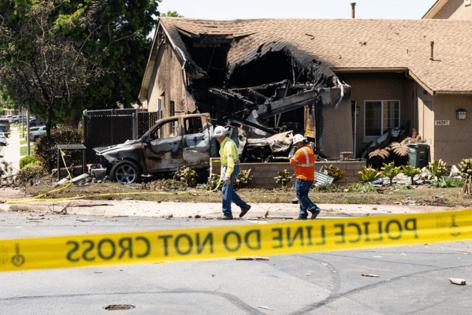At least 3 die on plane that crashed into San Diego neighborhood, leaving 'gigantic debris field'
Published in News & Features
SAN DIEGO — A private jet flying in dense fog crashed into a San Diego neighborhood early Thursday morning, killing at least three and sparking intense flames that scorched several homes, mangled dozens of vehicles, and forced almost 100 people to evacuate.
The only people known to have died in the crash were aboard the aircraft, which appeared to have struck power lines, according to federal officials.
A spokesperson for Sound Talent Group, a San Diego-based music agency, confirmed to The Times that the company lost three employees in the crash, including Dave Shapiro, the group’s co-founder. The other employees were not named.
“We are devastated by the loss of our co-founder, colleagues and friends,” read a company statement. “Our hearts go out to their families and to everyone impacted by today’s tragedy. Thank you so much for respecting their privacy at this time.”
The Cessna 550 jet, which can accommodate up to 10 people, was registered to Daviator LLC based in Homer, Alaska, according to FAA records. The company’s registered agent, Shapiro, is a certified flight instructor and airline transport pilot.
The jet crashed into a military housing community in the Murphy Canyon area just before 4 a.m. Thursday, according to San Diego Fire-Rescue Department Assistant Chief Dan Eddy. Officials have yet to say exactly how many aircraft occupants perished, but did confirm that no residents were killed in the crash.
“Crews arrived on scene to find multiple homes and cars on fire,” Eddy said at a news conference. Firefighters have since been able to quell the flames, but at least 10 homes were severely damaged, he said, and a block of vehicles were left completely mangled — at least a dozen, according to footage from the scene.
At least eight residents were hurt, all with minor injuries, Eddy said. One was taken to the hospital, while the others were treated for minor injuries at a nearby evacuation center.
“There’s plane everywhere,” Eddy said, calling the scene a “gigantic debris field.”
The smell of jet fuel and burnt wood was still overwhelming in Murphy Canyon, even blocks away from the crash and hours later. One single-family home had a massive, charred hole on one side, while nearby cars were almost completely flattened.
But the damage throughout the neighborhood was sporadic.
On one side of the street, a home had been scorched, its roof caved in. But just across the way, the lot appeared untouched.
Nearby, what had been a parked sedan was now burned beyond recognition — the hood and all four doors blown open. On another section of the road that appeared damage-free, the rear of a Honda Accord was completely melted by the flames, its metal dripping into a puddle on the ground.
A young resident riding his scooter through neighborhood seemed puzzled by the scattered damage: “How did it go from there to there?” he asked himself.
Another resident described the impact of the plane as being like an earthquake. He said he heard a loud boom, and when he stepped outside, he saw the plane and the surrounding fire and wreckage.
“I can’t quite put words to describe what this scene looked like, jet fuel going down the street, everything on fire all at once,” said San Diego Police Chief Scott Wahl. “It was pretty horrific.”
City Council member Raul Campillo, who represents the neighborhood, said he met some of the military families who evacuated in exceptionally challenging conditions, with help from each other and first responders.
“I heard stories ... about military families helping military families out of their homes, jumping out of windows, avoiding fire,” Campillo said. “We know there was many miracles and many heroic actions.”
Wahl said almost 100 people have been displaced from the crash and the area remains closed for continued investigations and cleanup.
The private plane took off from Teterboro Airport in New Jersey around 11:15 p.m. Wednesday and stopped for just under an hour in Wichita, Kan., according to the flight tracking site FlightAware. It was headed for Montgomery-Gibbs Executive Airport, a general aviation airport owned by the city of San Diego and located less than three miles from the crash site.
Shortly after 3:40 a.m. the pilot announced on the radio that the plane was three miles away from landing on runway 28, according to a recording from LiveATC.net. The pilot did not signal any problem with the aircraft and did not issue a distress call in the recordings reviewed by the Los Angeles Times.
The crash was reported at 3:47 a.m.
The National Transportation Safety Board was en route to investigate along with the FAA, Eddy said. He declined to comment on the focus of the investigation, but it appeared visibility or nearby power lines could have been factors.
Dense fog had rolled into the area around the time the plane was approaching the airport. Visibility was at half a mile at 3:55 a.m. and had dropped to a quarter of a mile just after 4 a.m. in the area around the Marine Corps Air Station Miramar, which is just a few miles north of the crash site, according to the National Weather Service.
“We had a marine layer that was deep enough that the clouds got into some of the valleys this morning,” said Adam Roser, a meteorologist with the National Weather Service in San Diego. “This one kind of crept in from the ocean into the valley and led to some of those foggy conditions.”
Eddy said that investigators were also looking into a debris field under some power lines not far from the neighborhood where the plane crashed.
“There’s a clipped power line behind us back there,” Eddy said. “We’re trying to figure out if that was involved from the plane.”
Experts say investigators are likely scrutinizing several aspects of the flight in their effort to determine what caused the crash, including weather conditions, potential pilot fatigue and whether the plane’s navigational aids were working.
“There is never one hazard that becomes a causal factor in an aircraft accident like this,” said Thomas Anthony, director of the Aviation Safety and Security Program at USC. “It’s always a combination of multiple hazards.”
The executive airport’s control tower was not staffed at the time the flight was approaching so the separation from other aircraft would have been handled by Southern California Approach Control, Anthony said. He downplayed what issues the lack of staffing may have caused, given that flights routinely takeoff and land during the overnight hours when the tower is closed. At this point, the weather and time are likely the key factors in the investigation, Anthony said.
“If you’re leaving from Teterboro and then landing in Wichita for gas, the question is how long have the pilots been awake?” Anthony said. “It’s a crucial issue because one of the human factors that reduces the safety margins is fatigue. Fatigue erodes our decision-making capability and it also makes us less likely to communicate or communicate well.”
“There is also, at 3:47 a.m., a sort of self-induced pressure to make it work or to get to where you want to go,” he added.
Given the lower visibility near the airport, experts say the pilot was likely operating under Instrument Flight Rules in which pilots adhere to specific regulations that allow them to navigate and control the aircraft using instruments in low-visibility conditions. A pilot taking off under instrument flight rules is “perfectly safe as long as the airplane is qualified for it and the pilot is qualified for it,” said Robert L. Ditchey, a former Navy pilot and an aviation consultant. “It’s done every day all over the world.”
_____
©2025 Los Angeles Times. Visit at latimes.com. Distributed by Tribune Content Agency, LLC.







Comments